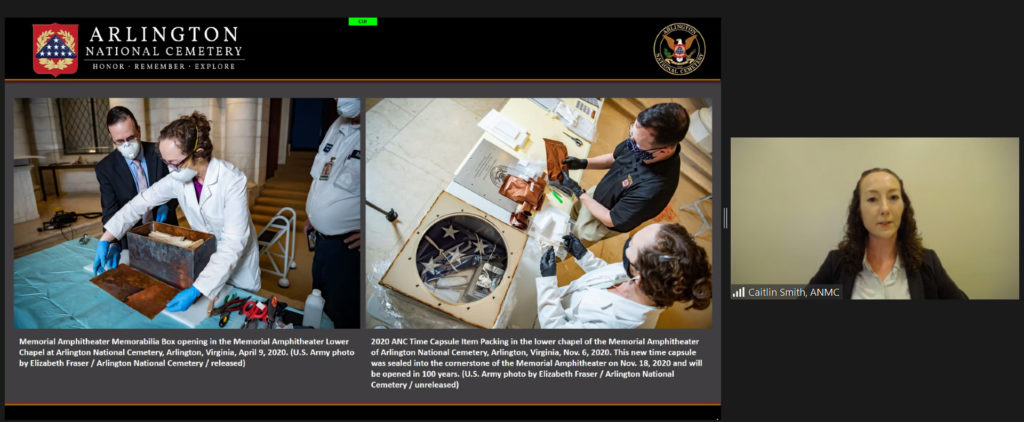On October 7th, the Washington Conservation Guild was joined by Caitlin Smith, the Conservation Program Manager at the Army National Military Cemeteries (AMNC). Smith presented a variety of exciting topics, including the conservation work completed for the centennial of the Memorial Amphitheater and the Tomb of the Unknown Soldier.

Smith began her talk by discussing the site’s history. The Army National Military Cemeteries include two sites: (1) the United States Soldiers’ and Airmen’s Home National Cemetery and (2) Arlington National Cemetery. The Soldiers’ and Airmen’s National Cemetery, the older and smaller of the two, was built in 1861. The Arlington National Cemetery was built in 1864 on land that once belonged to Mary Ann Randolph Custis, wife of Robert E. Lee and descendent of George and Martha Washington. At the onset of the Civil War, the land was occupied by federal troops as a camp, and in 1863, a Freedman’s Village was established at the site. The first military burial at Arlington took place on May 13th, 1864. Today, the National Cemetery is 39 acres and expanding with up to 30 funerals a day.
As the first conservator for the AMNC, Smith has been actively building a conservation program for the sites alongside Cultural Resource Manager Rebecca Stevens. The conservation department for AMNC is situated within the engineering department alongside a team of specialists who work on a wide range of projects. Smith notes that building up a new program within a well-established system can be difficult, especially at a site that serves many functions. The AMNC is an army installation, public site of remembrance, arboretum, host for sacred events, and a national shrine. The preservation program balances many missions and different audiences in its care for over 308 historic structures.
Smith shared two case studies of her work at the AMNC: the rehabilitation of the Memorial Amphitheatre for its centennial in 2020 and the treatment of the Tomb of the Unknown Soldier for its centennial in 2021. Both projects included the application of zinc oxide in the treatment of biofilm, a method developed in concert with Judy Jacob of the National Park Service. Additional treatment included stain reduction on the plaza in the areas where the Honor Guard walks in their steel toes. A selective reduction was pursued in consultation with the Old Guard, leaving traces of the staining as evidence of their historic watch. A video with additional details of the treatments can be found at the link here: https://www.youtube.com/watch?v=bZeDFqLPD-Y.
Smith closed her presentation with a reminder about the Centennial Commemoration Program for the Tomb of the Unknown Soldier this coming November.
Summary by: Abby Rodriguez
Meeting venue: virtual
Attendance: 41 participants